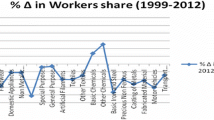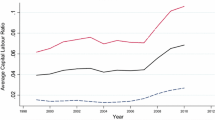Abstract
The present paper provides an evidence-based enquiry into the causes of low productivity, polarised industry structure and their relations with labour market institutions in major states of India. Unit level data of NSSO’s 73rd Round of Unincorporated Enterprise Survey for the year 2015–16 and ASI 2015–16 unit level data have been used to estimate relevant parameters and these are cross-checked by using NSSO’s 67th Round of Unincorporated Enterprise Survey for the year 2009–10 and ASI 2009–10. The debate that took place during the late 1990s and early years of the first decade of the twenty-first century was mainly centred on explaining the reasons for low productivity syndrome as pro-labour and anti-labour policies nurturing or weakening particular labour market institutions. However, the present study shows that the broader institutional environments, which are very sticky unless the state consciously makes attempts to change through mass involvement and strict laws, under which labour market institutions operate, state policies are framed and implemented play the most determining role in the evolution of industry structure and the performance of the industry. Pro-business institutional environments are lacking and anti-establishment institutions are prominent in many states where mobility of micro and small firms along the size-ladder has been highly restricted which results in polarised structure or the so-called phenomenon of “missing middle” and low productivity of a large majority of the workers.
Similar content being viewed by others
Data Availability
ASI 2015–16 Unit level data and &73rd Round NSSO unit level data on unincorporated non-agricultural sector enterprises.
Code Availability
STATA15 software has been used to process unit level data. It uses simple commands.
Notes
Singur is a census town in Singur CD Block in Chandannagore subdivision of Hooghly district in West Bengal.
Ibid.
Ibid.
References
Adams, Z., Bishop, L., Deakin, S., Fenwick, C., Garzelli, S. M., and Rusconi, G. 2018. The economic significance of laws relating to employment protection and different forms of employment: analysis of a panel of 117 Countries, 1990– 2013. ECGI Working Paper Series in Law, Working Paper N° 406/2018.
Ahsan, A and Pagés, C. 2008. Are all labor regulations equal? evidence from Indian manufacturing. IZA Discussion Paper No. 3394.
Albin, Alice. 1990. Manufacturing sector in Kerala: comparative study of its growth and structure. Economic and Political Weekly 25 (37): 2059–2070.
Bertola, Giuseppe. 1990. Job security, employment and wages. European Economic Review 34 (4): 851–879.
Besley, T., and R. Burgess. 2004. Can regulation hinder economic performance? evidence from India. Quarterly Journal of Economics 119 (1): 91–134.
Bhalotra, Sonia. 1998. The puzzle of jobless growth in indian manufacturing. Oxford Bulletin of Economics & Statistics 60 (1): 5–32.
Bhattacharjea, Aditya. 2006. Labour market regulation and industrial performance in India: A critical review of the empirical evidence. The Indian Journal of Labour Economics 49 (2): 211–32.
Bhattacharjea, A. 2009. The Effects of Employment Protection Legislation on Indian Manufacturing. CDDRL Working Paper, Stanford University, available at http://cddrl.stanford.edu/publications/the_effects_of_employment_protection_legi slation_on_indian_manufacturing/
Bhattacharjea, Aditya. 2012. Did kaldor anticipate the new economic geography? yes, but. Cambridge Journal of Economics 34: 1057–1074.
Bhattacharjea, A. 2019. Labour market flexibility in Indian industry a critical survey of the literature. CDE, ISSN No. 2454 – 1427.
Biswas, P.K. 2010. Systems of education, training and skill formation: how relevant for small enterprises? In Micro and small enterprises in India: the era of reforms, ed. Keshab Das. India: Routledge.
Biswas, P.K. 2016. Corporate retailing in the advanced countries: some salient seatures. In Economic challenges for the contemporary world: essays in honour of Prabhat Patnaik, ed. Das, Mausumi, Sabyasachi Kar and Nandan Nawn. New Delhi: Sage Publications.
Biswas, P.K., and A. Raj. 1996. Skill formation in the indigenous institutions: cases from India. In Skill and technological change: society and institutions in international perspective, ed. Parthasarathi Banerjee and Yoshihiro Sato. New Delhi: Har-Anand Publications.
Biswas, P.K. and S. Pohit. 2015. Performance of informal sectors. In India: Science and Technology Volume 3, ed. CSIR-NISTADS. New Delhi: CUP.
Blanchard, O., and Augustin Landier. 2002. The Perverse effects of partial labour market reform: fixed-term contracts in France. The Economic Journal 112 (480): F214–F244. https://doi.org/10.1111/1468-0297.00047.
Boeri, Tito. 1999. Enforcement of employment security regulations, on-the-job search and unemployment duration. European Economic Review 43 (1): 65–89.
Cahuc, P., and F. Postel-Vinay. 2002. Temporary jobs, employment protection and labor market performance. Labour Economics 9 (1): 63–91.
Daugherty, S., R. Herd, and T. Chalaux. 2009. What is holding back productivity growth in India? recent microevidence. OECD Journal: Economic Studies 2009: 1–22.
Fallon, Peter R. 1987. The effects of labor regulation upon industrial employment in india. World Bank, Report No. DRD287.
Fallon, Peter R., and Robert E.B.. Lucas. 1991. The impact of changes in job security regulations in India and Zimbabwe. The World Bank Economic Review 5 (3): 395–413. https://doi.org/10.1093/wber/5.3.395.
Fallon, Peter R., and Robert E.B.. Lucas. 1993. Job security regulations and the dynamic demand for industrial labor in India and Zimbabwe. Journal of Development Economics 40 (2): 241–275.
Goldar, B., and S. Aggarwal. 2010. Informalization of industrial labour in India: Are labour market rigidities and growing import competition to blame?. Presented at the 6th Annual Conference on Economic Growth and Development, December 16–18, 2010, Indian Statistical Institute, New Delhi.
Hasan, Rana, D. Mitra, and K.V. Ramaswamy. 2007. Trade reforms, labor regulations, and labour-demand elasticities: empirical evidence from India. The Review of Economics and Statistics 89 (3): 466–481.
Hsieh, Chang-Tai., and B. Olken. 2014. The missing ‘missing middle.’ Journal of Economic Perspectives 28 (3): 89–108.
Mazumdar, Dipak, and S. Sarkar. 2009. The employment problem in India and the phenomenon of the missing middle. Indian Journal of Labour Economics 52 (1): 43–55.
Oommen, M.A. 1979. Inter-state shifting of industries: a case study of South India. Trichur: University of Calicut.
Piore, Michael. 1986. The decline of mass production and the challenge to union survival. Industrial Relations Journal 17 (3): 207–213.
Roy, S.D. 2004. Employment dynamics in indian industry: adjustment lags and the impact of job security regulations. Journal of Development Economics 73 (1): 233–256.
Storm, S. 2019. Labor laws and manufacturing performance in India: how priors trump evidence and progress gets stalled. Institute for New Economic Thinking, Working Paper 90.
Subrahmanian, K.K. 2003. Regional industrial growth under economic liberalization: a case study of selected issues with reference to Kerala State. New Delhi: Manak Publishers Private Ltd.
Subrahmanian, K.K., and P. Mohanan. Pillai. 1986. Kerala’s industrial backwardness: exploration of alternate hypotheses. Economic and Political Weekly 21 (14): 577–592.
Subramanian, K.V. 2018. Dismissal laws, innovation, and economic growth. ADBI Working Paper 846.
Teitelbaum, Emmanuel. 2012. Mobilizing restraint: democracy and industrial conflict in post-reform South Asia. New Delhi: Cambridge University Press.
Thampy, M.M. 1990. Wage cost and Kerala’s industrial stagnation: study of organized small-scale sector. Economic and Political Weekly 25 (37): 2077–2082.
Thomas, J.J 2005. Kerala’s industrial backwardness: a case of path dependence in industrialization?. ISAS Background Brief, No. 3, Dated 15th May, Institute of South Asian Studies.
Funding
Not applicable.
Author information
Authors and Affiliations
Contributions
Both contributed.
Corresponding author
Ethics declarations
Conflicts of interest
The authors declare that they have no conflict of interest.
Additional information
Publisher's Note
Springer Nature remains neutral with regard to jurisdictional claims in published maps and institutional affiliations.
Rights and permissions
About this article
Cite this article
Biswas, P.K., Bandyopadhyay, S. Labour Market Institutions, Industry Structure and Productivity in Indian Manufacturing Sector. Ind. J. Labour Econ. 64, 999–1021 (2021). https://doi.org/10.1007/s41027-021-00339-5
Accepted:
Published:
Issue Date:
DOI: https://doi.org/10.1007/s41027-021-00339-5




